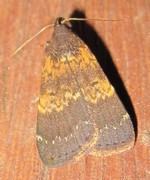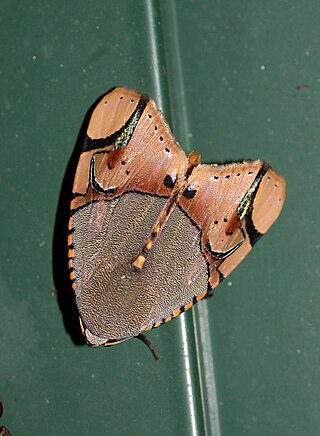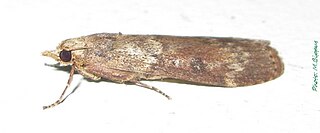
Orgyia is a genus of tussock moths of the family Erebidae. The genus was described by Ochsenheimer in 1810. The species are cosmopolitan, except for the Neotropical realm.

Argina is a genus of tiger moths in the family Erebidae. They are distributed throughout Africa, Mauritius, China, India, Sri Lanka, Myanmar, Andaman Islands, New Guinea and Australia.

Chamaita is a genus of moths in the subfamily Arctiinae. The genus was erected by Francis Walker in 1862. Species are distributed throughout India, Sri Lanka, and Borneo.
Holocraspedon is a genus of moths in the family Erebidae first described by George Hampson in 1893.

Miltochrista is a genus of moths of the family Erebidae, subfamily Arctiinae. The genus was erected by Jacob Hübner in 1819.

Nudaria is a genus of moths in the subfamily Arctiinae erected by Adrian Hardy Haworth in 1809.

Lymantria is a genus of tussock moths in the family Erebidae. They are widely distributed throughout Europe, Japan, India, Sri Lanka, Myanmar, Java, and Celebes. The genus was erected by Jacob Hübner in 1819.
Dierna is a genus of moths of the family Erebidae erected by Francis Walker in 1859.

Hydrillodes is a genus of litter moths of the family Erebidae first described by Achille Guenée in 1854. Its validity is somewhat disputed.

Ramadasa is a genus of moths of the family Noctuidae described by Frederic Moore in 1877.
Talapa is a genus of moths of the family Erebidae. The genus was erected by Frederic Moore in 1867.
Cozola is a genus of tussock moths in the family Erebidae. The genus was erected by Francis Walker in 1865.

Laelia is a genus of tussock moths in the family Erebidae. The genus was described by Stephens in 1828. Species are well distributed throughout Europe, Japan, China, India, Sri Lanka, Myanmar and Java.

Leucoma is a genus of tussock moths in the family Erebidae. The species are well distributed in Palearctic, Ethiopian, and Oriental regions along with New Britain and Ireland. It was described by Jacob Hübner in 1822.
Pantana is a genus of tussock moths in the family Erebidae. The genus was erected by Francis Walker in 1855.

Perina is a genus of tussock moths in the family Erebidae. It was described by Francis Walker in 1855 and is found in China, Sri Lanka and throughout India.
Bylazora is a genus of moths in the family Geometridae described by Francis Walker in 1863.

Fascellina is a genus of moths in the family Geometridae described by Francis Walker in 1860.
Nadagara is a genus of moths in the family Geometridae first described by Francis Walker in 1861.

Lamoria is a genus of small moths belonging to the family Pyralidae.












